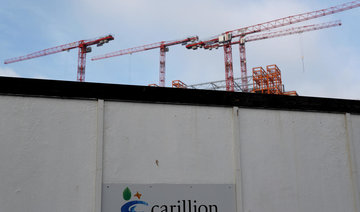LONDON: Qatar’s refusal to settle a £200 million bill is said to have been one of the final nails in the coffin for UK construction giant Carillion, which went into liquidation on Monday.
Carillion claims payment is outstanding for work on a £500 million ($692 million) development deal related to the 2022 World Cup.
Rudi Klein, chief executive of the Specialist Engineering Contractors’ (SEC) Group, said the Qatar contract was among a small number of “big infrastructure projects that meant the end was nigh for Carillion.”
“The Qatari government will be now looking very urgently for alternative contractors to do this work and they may have to pay rather a lot more to do that,” Klein told Arab News.
The unsettled debt is the latest shadow to engulf preparations for the World Cup in 2022.
Controversy was initially cast over Qatar’s 2022 World Cup bid when allegations of corruption emerged followed by reports of exploitation from the construction sites, where workers complained of inhumane conditions and unpaid wages.
Contractors then warned of delays to World Cup projects in June 2017 when Gulf countries began the ongoing boycott of Qatar.
The Qatari government now faces further complications with the collapse of Carillon, which was involved in the $5.5 billion Msheireb redevelopment of Doha’s Downtown ahead of the World Cup.
In October 2017, City A.M. reported that top Carillion executives were making monthly trips to Doha to persuade Msheireb, backed by the Qatar Foundation, to settle the outstanding bill.
Msheireb, however, says it is owed a significant sum for contractural obligations it claims Carillon has failed to fulfil.
Carillion is one of the largest contractors operating in the Middle East, with projects including the Dubai Canal and the Royal Opera House in Oman, mostly through joint ventures.
The fall in oil prices contributed to a slow down in construction spending across the region, prompting Carillion to start pulling out of Middle East markets.
Commentators criticizing Carillion’s construction delivery model in the wake of its downfall emphasized the danger inherent in its practice of outsourcing on a large scale, particularly when operating in overseas markets.
“In the Middle East, where construction works are delivered very site-labor intensively and with high proportions of unskilled transient migrant labor, the delivery failure risks in terms of cost overruns, delays and quality problems can be magnified,” said Mark Farmer, CEO of Cast, a real estate and construction consultancy.
“This undoubtedly creates heightened risk for those contractors that are not able to adequately supervise or control and manage the construction process.”
Klein said Carillion’s role as a “middleman” left the company ill-equipped to supervise projects, which could be more efficiently managed by smaller, regional contractors. Klein added, “95 percent of what Carillion did was outsourced; they never did a thing.
“Now is time to get rid of the middleman and to look at how we engage directly with the people actually doing the work.”
The collapse of Carillion was a dramatic unraveling of the UK’s second-largest construction firm, which employs 43,000 people worldwide, including 19,000 workers in the Gulf.
British Prime Minister Theresa May on Wednesday defended the government’s decision to sign major deals with the company after it issued its first profit warning in July. Carillion has public sector and private partnership contracts worth £1.7 billion in the UK, including for services in the NHS and Ministry of Defense.
“We’re making sure in this case that public services continue to be provided, that workers in those public services are supported and taxpayers are protected,” May told MPs.
Labour leader Jeremy Corbyn accused the British government of “negligence” over Carillon and called on May to “end the costly racket of private companies running services for the public.”
Carillion’s demise is being compared to the impact of the Lehman Brothers’ collapse on the banking sector as the reverberations reach further down the supply chain.
Brian Berry chief executive of the Federation of Master Builders warned that the “domino effect” is already underway.
“This is the biggest thing that’s hit the construction industry since I can remember; it’s got the potential to be a disaster.”
Thousands of suppliers are owed money by Carillion, many of which are having to lay off workers as banks call in their debts. Shareholders are also among those suffering severe losses.
Along with the Qatar contract, three UK joint public and private contracts are also being blamed for the collapse. Two were for new hospitals and another for a road project in Scotland.
Qatar’s unpaid World Cup 2022 contract in spotlight amid anger over Carillion collapse
Qatar’s unpaid World Cup 2022 contract in spotlight amid anger over Carillion collapse

Mapping Saudi soils to grow better crops

- Palm trees, root crops, and coastal plants reveal the land’s story
RIYADH: Saudi Arabia’s land tells stories written beneath the feet. From fertile plains and rugged highlands to vast deserts, the Kingdom’s diverse landscapes shape what can grow, where it grows, and how agriculture can thrive.
Alongside geography and climate, soil conditions play a decisive role in agricultural success. Understanding soil types across the Kingdom helps determine which crops can flourish and what interventions may be needed to sustain them.
In an interview with Arab News, Turki Almutairi, a senior environmental specialist at the National Afforestation Center under the National Center for Vegetation Cover Development and Combating Desertification, outlined the main soil types found across Saudi Arabia.

“The dominant soil in the Kingdom are sandy desert soils, alongside calcareous soils in the central region. Rocky and stony soils are present along mountainous and hilly landscapes,” he said.
“Alluvial soils are common in wadies (valleys), while saline and sodic soils are located in depressions (Sabkhas) and along coastlines. Pockets of clayed soils can be also found around few sites along the Kingdom.”
The Kingdom’s vast territory gives rise to unique soil characteristics in each region, enabling different crops to grow depending on local conditions.
“Soil is the growing medium for plants. The role of soil includes structural stabilization, providing nutrients and a communication medium for plants,” Basil Nasir, soil lead at engineering consultancy William Sale Partnership, told Arab News.

According to Nasir, assessing soil use is essential before determining whether it is fertile or infertile, as different soils support different plant types.
“The soil used for trees differs from the soil used for ornamental plants and from the soil used for aquatic plants. It varies according to the specific needs of each plant, and based on this, we determine what the soil requires and assess its fertility,” he said.
Nasir explained that soil characteristics are shaped by both physical and chemical components. In addition to water and air, mineral particles such as sand, silt and clay are key indicators of soil health. Organic matter, derived from plant and animal remains, forms the fourth major component.
The balance between these elements determines soil behavior. One important physical trait is water-holding capacity, which influences what types of plants a soil can support.
Opinion
This section contains relevant reference points, placed in (Opinion field)
“If the soil is like dunes, adding water will cause it to run off, but if the soil is clay, its ability to retain water will be very high. If you add water and return the next day, you will find that the water is still there,” said Nasir.
Chemical properties, such as whether soil is alkaline or acidic, are equally important. Understanding both physical and chemical traits allows for proper assessment and treatment when needed.
“What determines whether a plant is suitable for a particular environment is primarily the plant's nature. For example, some plants have fibrous roots and therefore do not require well-draining soil,” Nasir added.
“A palm tree, for example, does not care whether it was planted in one soil or the other because its roots are fibrous. Therefore, palm trees are strong plants and are suitable to grow in both dry and wetlands, while preferring sandy areas.”

Crops such as potatoes, onions, carrots and beetroots — where the edible part grows underground — typically thrive in sandy soils. As a result, plantations of these crops are commonly found in northern regions such as Hail and in Wadi Ad-Dawasir.
In the eastern region, including Al-Ahsa, wetlands are more common due to climatic conditions. Growing plants in such environments often requires human intervention.
“Plants that are coastal or could be found in lagoons or lakes must have some sort of soil around them, like lotus flowers and mangrove trees.”
“An important parameter to keep in mind is that there is no air in its soil, and they are adapted to this condition. However, the lack of air, along with the presence of organic matter, will create a situation where anaerobic bacteria react with the soil, potentially causing diseases we can easily avoid,” said Nasir.
He emphasized that removing organic matter from such soils is essential to ensure plant survival in aquatic environments.
Mountainous and rocky regions in Saudi Arabia are generally volcanic, resulting in low water-holding capacity and challenging growing conditions. However, volcanic ash contributes to high fertility, allowing certain crops to flourish.
As a result, western regions support tree crops such as coffee, mangoes, some banana varieties and pomegranates.

As development accelerates across the Kingdom, soil improvement efforts are expanding under the National Greening Program.
“Soil is considered fundamental for the National Greening Program’s objectives. Understanding the soil variability along the Kingdom is a precondition for fostering sustainable soil management,” Almutairi told Arab News.
Adding, “In this line, the NGP is working towards the establishment of the Saudi Soil Information System (TURBA-KSA), which consists of mapping soils and its functional properties in the Kingdom using state-of-the-art technology.”
He also noted the creation of the “Land Rehabilitation Watch” to report, verify and monitor land rehabilitation nationwide.
“This milestone allows the Kingdom to understand how soil and land health are progressing against national and international targets of land degradation neutrality. Documenting good soil and land management practices is also important, so that those successful practices could be scaled up along the Kingdom, which is a priority task for NGP,” he said.
Raising public awareness is another key pillar of the program.
“Assessing different emerging technologies and soil amendments is a daily activity of NGP, as it then provides technical support to partners on the selection and application of these technologies.”
DID YOU KNOW?
• Saudi Arabia cultivates around 1 million hectares, mainly in Riyadh, Qassim, Hail, and Jouf.
• Farming follows the seasons: winter brings onions, garlic, and carrots, while summer yields watermelon, tomatoes, and cucumbers.
• The Kingdom is a top date producer, with over 31 million palm trees generating nearly 1.54 million tons, especially in Riyadh and Qassim.
Almutairi stressed that soil is often overlooked because it lies unseen beneath the surface, despite its critical role.
Yet soil produces 95 percent of food, stores water, holds more carbon than vegetation and the atmosphere, suppresses contaminants, regulates water, carbon and nutrient cycles, and hosts microorganisms linked to the human microbiome.
He emphasized the need to engage the general public, particularly urban communities disconnected from nature. Education helps people understand where food comes from and how contact with soil — such as walking barefoot — can support well-being. Healthy soils also contribute to cleaner water and air, he added.
Almutairi also called for stronger advocacy among decision-makers, noting that investment in healthy soils supports climate action, food security and sustainable development.
He concluded that key strategies include officially observing UN World Soil Day on Dec. 5, integrating soil education into curricula, launching annual social media campaigns, using art to raise awareness, and organizing public events that connect soils to everyday life.















